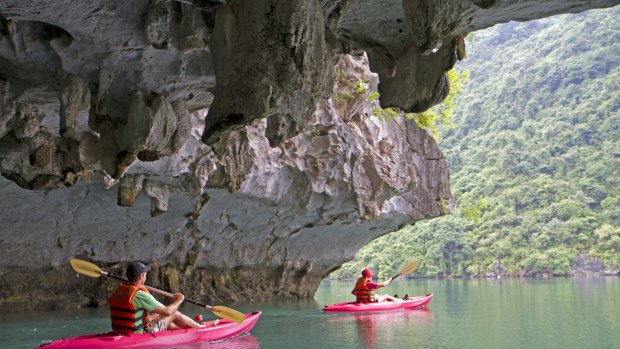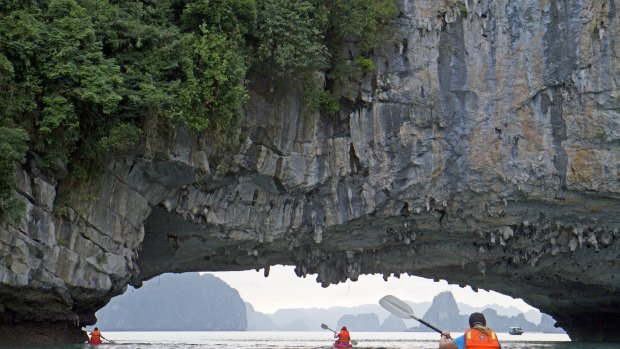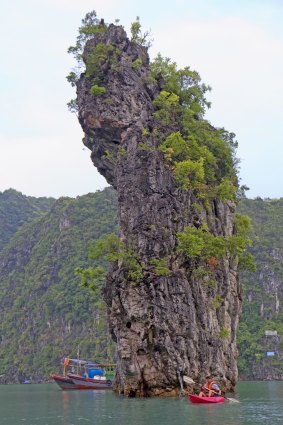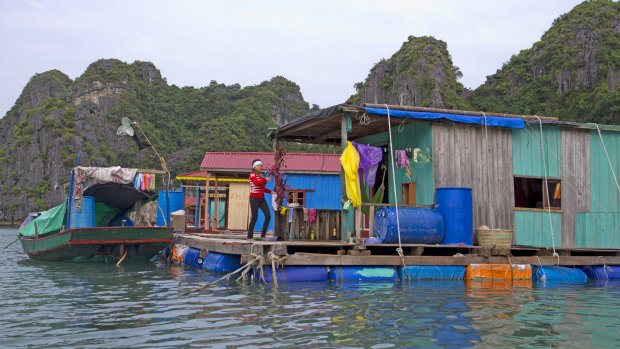This was published 9 years ago
Kayaking in Halong Bay, Vietnam: An oar inspiring glide
Kayaking provides a new perspective on beautiful Halong Bay, writes Andrew Bain.
By Andrew Bain

Wonder of the world: Kayaking through a cave.Credit: Andrew Bain
It's a few minutes past midday in Halong Bay, and the world seems to be on the move. A swarm of tourist junks pulls anchor in the waters off Halong City, and the ships fan out across the sea, pushing through the haze and weaving through the islands of Vietnam's most famous bay.
Two hours later, the ships come together again as one for the obligatory first port of call at one of Halong Bay's floating fishing villages. And so it goes, day after day, year after year, in a place where the travel experience can be as routine as it is spectacular.
Boat trips in the World Heritage-listed bay typically follow regimented schedules, and there's little visitors can do to vary the visit. But having a kayak is one such way.

Under a sea arch in Halong Bay.Credit: Andrew Bain
I've come to see Halong Bay from a paddling perspective. Pure, point-to-point kayak journeys aren't really possible here, with no accommodation or camping in reach through the bay. But by combining a standard boat tour with a kayak, a whole new Halong Bay can be unveiled. We share our ship - the Marguerite - with 10 other travellers, but our experiences are as distinct as if we were in different countries.
At Vung Vieng, the first of a handful of traditional floating villages in Halong Bay, the armada of tourist ships gathers like a gawking crowd. Passengers are ferried to a pontoon, from where the bulk of them will be sedately rowed through the village by residents.
Weaving through the rowboats as they leave the pontoon are our kayaks. While the boats drift past the village's lines of colourful wooden homes before returning to the ships, we're free to paddle wherever whim and tides take us.

A limestone pillar.Credit: Andrew Bain
In this maze-like island landscape, small bays turn corners into even smaller bays. Fishing boats materialise, and skeletal shipwrecks dot the shores, looking like the picked-over carcasses of an African kill. Crabs scrape their carapaces against the rocks, and small blue corals bloom from the shallows of the seabed. The sun above is little more than a smudge in the perpetual haze.
Turning with the bays, we eventually paddle into Vung Vieng, which is home to around 80 families and even has a floating primary school and a pearl farm. The homes balance on pontoons of their own, which are held in place by ropes bolted to the cliffs.
Past the village - out of sight and reach of the rowboats - a giant sea arch punctures the island, rising like a rainbow of rock and leading through to the more open seas and swells of the greater bay. As we paddle towards the arch, distant limestone spires become visible beyond, resembling teeth in the mouth of the arch.

The floating village of Vung Vieng. Credit: Andrew Bain
Through the arch we drift, paddling out into the small swell. Distant cargo ships and fishing boats crisscross through the bay, but it's the backdrop - the classic Halong Bay skyline - that overwhelms everything. Limestone pillars breach from the sea, and everywhere there are the domes and spires of one of the world's most instantly recognisable landscapes.
As impressive as the scenery is the knowledge of Halong Bay's natural numbers and accolades. Covering an area little bigger than Hong Kong, the bay's waters are pierced by almost 2000 islands, many of them taller than they are wide.
In 1994 the bay was inscribed on Unesco's World Heritage list, and in 2012 was named one of the New Seven Wonders of the World, alongside the likes of the Amazon forest and Iguazu Falls. If the high number of tourist boats here is disconcerting, it's also justified.
By the time we arrive back at the Marguerite, the sun is rolling away behind the islands. Our shipmates have long been back on deck, and happy hour at the bar is about to end, but I've already just enjoyed a couple of the happiest hours on water imaginable.
As we sail to our night's anchorage, where the sea is as calm as the vibe on the ship, darkness consumes the famous landscape. A multi-course dinner is served and later I'll lounge for a while in the chairs on the upper deck, drinking in a Dalat white wine and the breeze as others fish for squid over the bow of the ship, or try their hand at the art of spring-roll construction.
This combination of kayaking and sailing is an ideal water marriage, and not just for these sorts of evening luxuries. Halong Bay covers more than 1500 square kilometres, and in the ship we can quickly skip from location to location. In happy contrast, the kayaks allow us to explore the bay's intricacies, paddling far from the madding crowds.
The next morning the Marguerite whisks us to a new nook of the bay. Wrapped in an embrace of cliffs, tangled bush and sea, and home to around 700 people, Cua Van is the largest of Halong Bay's floating villages.
On this breathless morning, climbing into the kayaks is like stepping into our own reflections. Faint music drifts across the water from the village, and the surface of the sea is ironed flat. Fishing boats chug in and out of the village with entire families crouched on their decks, and a limestone stack as crooked as a broken finger rises in defiance of gravity. Though I'm reluctant to disturb the velvet-smooth water, we begin to paddle.
Instead of heading into the village, we turn, pointing our kayaks across the bay. We will paddle from one island to another, though in reality it's never quite clear where one island ends and another begins in this convoluted, fractured landscape. It's kayaking's equivalent of a house of mirrors.
On the opposite shores, the cliffs again engulf us as we squeeze through a narrow break at the edge of Cat Ba National Park and into a hidden lagoon. Schools of tiny fish skip across the water ahead of my kayak, and the scent of the ocean is all around us.
Over the next hour, our paddling journey will almost be the equivalent of caving in a kayak. Through a series of tunnels, caves and lagoons we'll bury ourselves deeper into the island until it feels almost as though we could be kayaking into oblivion.
In the first short tunnel, a column of weathered rock reaches down to the water like a set of tonsils. At its end we emerge a short distance from one of the area's most popular caves, Dark Cave, where at low tide you can venture into the deep darkness to explore with a head torch.
Right now, however, the tide is high and Dark Cave is inaccessible. It matters little, since one cave here is just a single figure in a vast crowd. Halong Bay's karst landscape is riddled with holes.
We turn away from Dark Cave and slip in under the low roof of another 50-metre-long tunnel. Bats click and swirl across the cave's ceiling, and soon we're paddling across another cavernous lagoon. Cliffs and thick bush surround us, towering into the sky.
At a glance it seems there's no possible exit here, other than the cave through which we entered. But at the far end, unseen until the last moment, a narrow crack splits the cliffs. Pulling in our shoulders and our breath, we squeeze inside.
Sunlight seeps in behind us, lighting the water in luminous colours. Fish hover inside the glow and, for a moment, it's like floating across an aquarium.
A few seconds later, there's momentary darkness, then pale light filters through once again from the cave's opposite end. Ducking beneath a rafter of rock, we emerge into yet another lagoon.
It feels almost as though we could go on like this forever, paddling from lagoon to lagoon, disappearing ever deeper into the guts of Halong Bay. But we have a lunch date back on the waiting ship.
We turn, and water fans in the wake of our kayaks. In this bay so busy with tourist ships and timetables, it's the only mark we'll leave.
FIVE OTHER ASIAN PADDLING TRIPS
Raja Ampat (Indonesia): A little-known, postcard-perfect group of 1500 tropical islands located off the western tip of New Guinea. See kayak4conservation.com
Kumano River (Japan): Kayak a World Heritage-listed pilgrimage route, where Shinto faithful once paddled through the Dorokyo Gorge to a sacred shrine. See kumano-experience.com
Pha Nang Bay (Thailand): Kayak through the surreal limestone islands made famous by the James Bond film, The Man with the Golden Gun. See worldexpeditions.com
Kerala Backwaters (India): The traditional way to see Kerala's famous Backwaters is in a houseboat, but more nimble kayaks are now also infiltrating the canals. See keralakayaking.com
Mongolia: Yes, landlocked Mongolia...in a canoe. See the steppe as you paddle, with canoe trips available along a handful of Mongolian rivers. See mongoliacanoeing.com
TRIP NOTES
MORE INFORMATION
GETTING THERE
Vietnam Airlines flies daily to Hanoi from Sydney and Melbourne. Flights transit through Ho Chi Minh City, requiring a change of terminal (a simple 10-minute walk); see vietnamairlines.com. Australians require a tourist visa to enter Vietnam - details and forms at vietnamembassy.org.au.
SEE + DO
World Expeditions operates an 11-day Bike, Hike and Kayak Northern Vietnam trip, which includes three days of kayaking and sailing on Halong Bay. The trip costs $2090 per person. See worldexpeditions.com.
The writer travelled as a guest of World Expeditions.
Sign up for the Traveller Deals newsletter
Get exclusive travel deals delivered straight to your inbox. Sign up now.